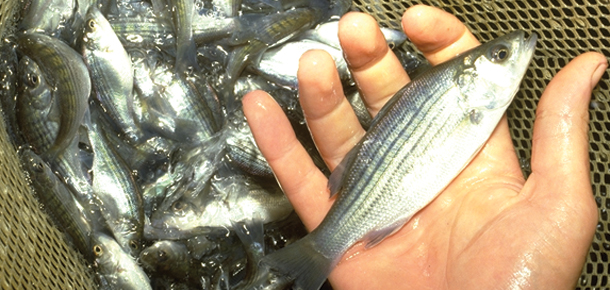Knauss legislative fellowships in Congress help build careers — and they're fun and educational. See our video and fact sheet for details.
Finfish Aquaculture

Maryland’s wild fisheries have been the focus of local economies and cultures for generations. But some state residents have turned to fish aquaculture at various points to supply a growing population with food and protect wild stocks.
While finfish aquaculture is not a major industry in Maryland today, growing fish like striped bass in a pond or in cages does have advantages. Farm-raised fish, for instance, grow faster than wild fish.
But there are disadvantages, too. An aquaculture business requires large initial investments and diligent upkeep. Fish grown in captivity catch and spread bacterial infections quickly, and they can easily deplete the oxygen supplies in a pond or cage.
To inform those interested in the practice, Maryland Sea Grant Extension specialists produced a workbook series and three videos on finfish aquaculture. Though dated, these fact sheets and videos still contain useful information for Marylanders interested in growing, rather than catching, their fish.
Fact Sheets
Our finfish workbook includes these fact sheets in pdf format:
- Fish Culture in Maryland: Weighing the Pros and Cons (Finfish Fact Sheet 1)
- Cage Culture in Maryland (Finfish Fact Sheet 2)
- The Culture of Striped Bass and Its Hybrids in Cages (Finfish Fact Sheet 3
- Figuring Production Costs in Finfish Aquaculture (Finfish Fact Sheet 4)
- Understanding Fish Pricing: From Production to Table (Finfish Fact Sheet 5)
- What is Aquaculture? (Finfish Fact Sheet 6)
- Liming Aquaculture and Farm Ponds in Maryland (Finfish Fact Sheet 7)
- Farm Pond Management: Increasing Production through Fertilization (Finfish Fact Sheet 8)
- Prevention and Disinfection of Mycobacterium sp. in Aquaculture (Finfish Fact Sheet 9)
Videos
We also have three finfish aquaculture instructional videos:
- Farming Fish in Open Ponds (24 minutes). Catfish, trout, tilapia, striped bass and its hybrids — for several decades, the commercial production of such fish in farm ponds in the United States has continued to expand. Like agriculture, success in raising fish depends first of all on knowledge and commitment. This video is an introduction to just what that commitment will mean in preparing ponds, stocking newly hatched fish (called fry) and fingerlings, feeding fish, managing water quality and harvesting and packing market-size fish.
- Cage Culture: Raising Fish in Ponds (24 minutes). Farmers interested in growing fish commercially can choose whether to raise fish in open ponds, in recirculating tanks, or in cages and net pens. This video production focuses on cage culture — it demonstrates methods of cage construction and gives examples of how to calculate stocking densities and how feeding levels are determined. In addition, the video examines the critical importance of water quality monitoring and pond management.
- Producing Striped Bass in Hatcheries (16 minutes). The striped bass that farmers rear in ponds begin life in hatcheries, where eggs from ripe females are removed for fertilization by male stripers or, if hybrids are to be made, by such species as white bass. This video opens with the capture and handling of brood stock from spawning grounds, then follows biologists who determine when female fish are ready to ovulate, and finally shows how they remove mature eggs and fertilize the eggs with sperm from male fish.
Other Aquaculture Resources
Aquaculture fact sheets from the Northeastern Regional Aquaculture Center in pdf format:
- Planning for Success in Your Aquaculture Business
- Freshwater Aquaculture Species for the Northeast
- Marine Aquaculture Species for the Northeast
- Aquaculture systems for the Northeast
- Fish Health Inspections: What They Are
- Aquaculture Risk Management






